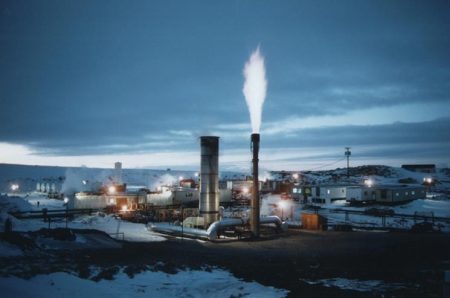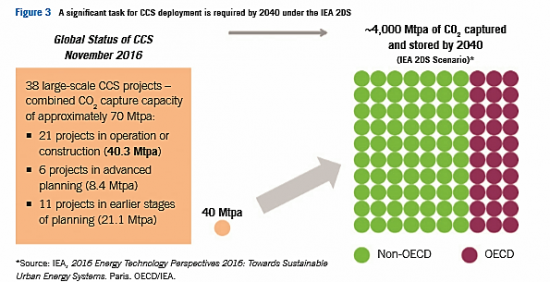December 3, 2016 – At COP22 in Marrakech, the Global CCS Institute tabled a summary report of where we are today in applying carbon capture technologies to the problem of global warming. Carbon capture and sequestration (CCS) may be our best mitigation technology for addressing greenhouse gas (GHG) emissions. Without it those writing this report believe the goals of the Paris Climate Agreement will be unattainable.
The problem is keeping global mean temperatures below a 2 Celsius (3.6 Fahrenheit) rise. The International Energy Agency (IEA) have stated that the only way to achieve this goal requires the capture and storage of almost 4,000 million tons of CO2 annually by 2040. This is 100 times the operational capacity of CCS technology deployed currently including new sites coming on line in 2017.
The summary report calls for “policy parity” for CCS and that it be given priority status both in research and development to ensure the world keeps below the 2 Celsius target. The exact words state, “widespread deployment of CCS will depend on the extent to which governments afford it policy parity – namely, the provision of an equitable level of consideration, recognition and support for CCS alongside other low-carbon technologies.”
So what is policy parity and how can it be achieved?
Policy parity requires government and industry to treat CCS as a major climate change mitigation option and include it in overall GHG reduction strategies. It means giving CCS equal consideration with low-carbon technologies such as renewable energy projects using wind, solar, geothermal and wave. This also means providing incentive mechanisms to stimulate the technology further faster. And it also means governments have to educate the public better so that they understand the implications of not deploying CCS against other mitigation options.
For example, currently there are more than 2,000 coal-fired power plants under construction or in development around the world. These are being built largely in Developing World nations. If CCS were deployed in these projects we could see close to net-zero carbon contributions from them. That would mean countries with access to coal as a fossil fuel source could continue to use it without further impacting global warming.
Another example would be to deploy CCS technology within industrial hubs since non-energy generating industry accounts for 25% (9,000 million tons annually) of global GHG emissions. This kind of cluster approach to CCS is being tried in the Netherlands but it has application on a global scale.
And finally, where utilities are implementing gas-fired power plants to replace coal, CCS could be deployed as well to create near net-zero carbon emissions.
CCS creates flexibility that allows for the continued use of fossil fuels while addressing the pollutants these energy sources produce.
And finally, policy parity, also recognizes that governments today remain conflicted about fossil fuel energy production. Just this week Canada approved two new oil pipelines which means the country intends to increase its oil production volume while still attempting to address carbon emission reductions. And this week BP announced a new major oil and natural gas project in the Gulf of Mexico, producing 280,000 barrels of oil per day and 60 million cubic feet of natural gas. If CCS were integrated into all of these fossil fuel energy decisions with a goal of creating near or net-zero-carbon neutrality then continuing to make such investments would make more sense in light of the climate change challenge we face.
The Current State of CCS
There are currently 38 large-scale CCS projects either in planning, construction or operation around the world. In addition there are hundreds of small pilot projects. Where are these projects? In Australia, Brazil, Canada, China, France, Germany, Iceland, Japan, the Netherlands, Norway, Saudi Arabia, South Korea, Spain, the United Arab Emirates, the United Kingdom and the United States. The 15 largest of these capture close to 30 million tons of CO2 annually. Three additional projects near to ready will contribute an additional 5 million tons. By the end of 2017, four more will come on line increasing the amount by another 5 million tons. The longest operating CCS facility is in Norway, the Sleipner CO2 Storage Project which since inception has sequestered more than 16 million tons of the gas.
What’s Stopping CCS Deployment
There remains concern on the part of the general public about CCS technology. What if the captured gas leaks out, or gets into groundwater? No existing facility has experienced such issues but public concern has been a drag on development and deployment.
In addition opponents of CCS argue that weaning ourselves from all fossil fuels is a better use of our resources and that spending time and money on capturing GHGs means we will continue to live with a polluting energy source.
In the case of the former the public needs to be better educated about every stage of the CCS process and the viability of permanent CO2 sequestration. Sharing Iceland’s experience with sequestration would explain the science.
As for the second it would be a more cogent argument if we didn’t see nations and energy companies around the world continue to make enormous investments in fossil fuel energy extraction and infrastructure.
CCS largely serves one purpose, sequestering CO2. It is also used for enhanced oil recovery and may even be deployed for geothermal energy closed cycle systems. It is a preventive, like taking birth control. And as long as we continue to burn fossil fuels to generate energy, it is the best technology to prevent CO2 from creating an imbalance of the gas in the atmosphere. That cannot be said of any renewable energy technology. At best all they do is displace the use of fossil fuels which may end up being burned in transportation or other endeavours.
What’s Needed to Make CCS Help the World Achieve the Less Than 2 Celsius Upper Limit
The report tabled at Marrakech states that through a dramatic increase in CCS deployment over the next 25 years allowing us to reach a storage capacity of 4,000 million tons of CO2 captured annually by 2040, we can meet the 2 Celsius upper limit. In the infographic below on the left we see where we currently are. On the right we see where we need to get to by 2040.
In the last ten years renewable energy investment has amounted to $2.5 trillion U.S. Of that $1.8 trillion has been spent on wind and solar technologies. This investment has been driven by strong and sustained policy support. And this investment to date has done nothing to stop the growing carbon emissions challenge we face.
A comparison in investment in CCS shows what I have described as the disparity of policy parity. Compare $2.5 trilllion to $20 billion, the amount to date spent on CCS in the same timeframe. The disparity is 120 times less. And the end result has been at best a tiny dent in the total volume of CO2 our modern industrial society produces.
There is no mitigating technology that directly removes CO2 from the atmosphere other than CCS. It is singularly addressing the cause of global warming and yet government and industry fail to see its efficacy.












